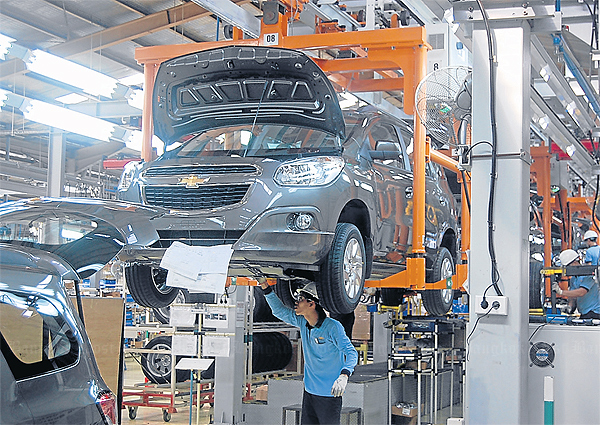General Motors, the American company behind the Chevrolet brand, is seeking a bigger role and more market share in Southeast Asia. It has rapidly expanded the lineup of products available in the region to lay the foundation for the next stage of growth. Its three-pronged strategy is to expand its manufacturing and supplier footprints as well as the retail network.

The Chevrolet Spin mini-MPV is being assembled in Indonesia for sale throughout Asia including Thailand, where prices will start around 760,000 baht.
“For Asean as a whole, all we can see is huge growth and enormous opportunities. The umbrella strategy is ‘build where you sell, and source where you build’,” said Martin Apfel, president of GM’s Southeast Asia operations, at the grand opening of the Phnom Penh distributorship earlier this month.
Chevrolet has appointed United Auto Trading, an affiliate of Goodwill Trading, one of the largest local importers and distributors of motor vehicles, as its sole authorised distributor of vehicles and parts and provider of after-sales service. The 2,000-square-metre flagship dealership first opened in February.
“One of the most important things in doing business is people, those we place our trust in, people with experience who are known to be honest and transparent,” said Mr Apfel, who is based in Thailand. “We have to take the people who know their stuff and have the ability and the will to take the brand to the next level.”
He forecast the Cambodian automobile industry would grow by 10-15% this year, with one-third of the market being mid-sized pickup trucks. Many people in Cambodia want a vehicle both for business and personal use, so the strategy will be to keep the right vehicles rolling into the market and ensure they are well-maintained with parts available at all times.
The Chevrolet Colorado pickup is well-suited to the Cambodian market, where GM expects to have a share of about 10% by the end of this year.
Tong Norm, the chairman of United Auto Trading, said the local market was still small but had high potential to grow rapidly thanks to improving economic conditions and the growing middle class. He said his company was looking to expand beyond the capital to cover Phra Tabong, Kampong Cham and Siem Reap.
In Thailand, Chevrolet plans to have 120 dealerships in place by the end of this year, a 29% increase. It also opened its first dealership in Laos last December.
“We will be buying auto parts worth about US$2 billion from suppliers in Southeast Asia this year, compared to just $300 million three years ago. This is almost a sevenfold increase, indicating our strong commitment in this region,” noted Mr Apfel.

GM Southeast Asia president Martin Apfel (left), joins Tong Norm (right) the authorised dealer in Cambodia, at a showroom opening in Phnom Penh.
The company will continue to use Thailand and Indonesia as its main production bases. GM this month opened its $150-million plant in Bekasi, 16 kilometres east of Jakarta, employing 700 people. Its main product will be the Chevrolet Spin, a seven-seat, mini-multipurpose vehicle (MPV) first pioneered in Brazil. The plant has a production capacity of 40,000 units a year.
“Indonesia is one of GM’s fastest-growing markets. Last year, we saw 17% growth in the country compared with 2011. The opening of this plant goes along with our big belief that we should build the vehicles where our market is and also sell and source our products there,” said Tim Lee, GM’s vice-president for global manufacturing and president of international operations.
About 80% of the Spins from the plant will be sold in Indonesia and the remainder will be exported to Thailand and the Philippines.
GM sold a total of 21,889 Chevrolet vehicles in the first quarter of 2013 in Southeast Asia, representing 17% growth over the same period last year. Thanks to booming economic conditions and growing number of middle-class people regionwide, GM expects substantially more car sales in the coming years.
Mr Apfel also acknowledged that continuing territorial tensions between China and Japan had had a positive impact on the company’s sales, as Chinese buyers have been looking for alternatives to Japanese products.
GM, he added, was looking forward to making a bigger contribution to the regional economy overall through the auto industry’s strong multiplier effect. Every vehicle manufacturing job creates between seven and 12 jobs in the supplier, dealership and service areas.
However, the auto industry and GM also face challenges on three main fronts, said Mr Apfel. The first is energy security and the rising cost of fuel. The second is education and training, given the serious shortage of skilled labor throughout the region.
“We need to build people. If you look at the global rankings, the skill to read, the skill to comprehend, the ability to analyse and to have debates with good solutions, these would be the largest gaps that countries in this region need to address in a timely manner,” he said.
The third challenge, he said, was the ongoing transition process to the Asean Economic Community (AEC) in 2015, which must be real and not just something on paper.
“The regulatory burden is still a problem in this region,” he said. “The ‘single window’ for customs procedures, we really need that to be an electronic window and not some place where we have to put boxes of papers next to it. Things ought to be more practical, because the free flow of goods will bring about economic growth here in Asean.”